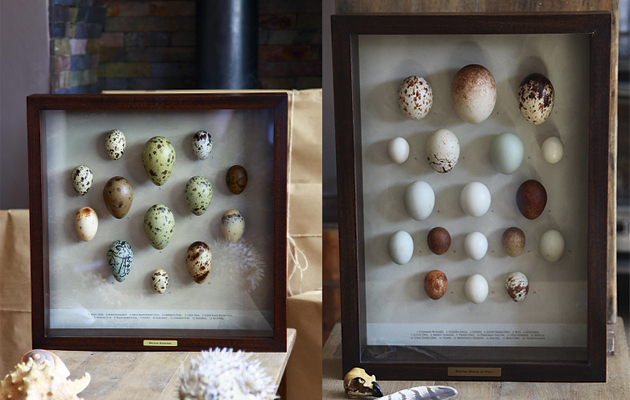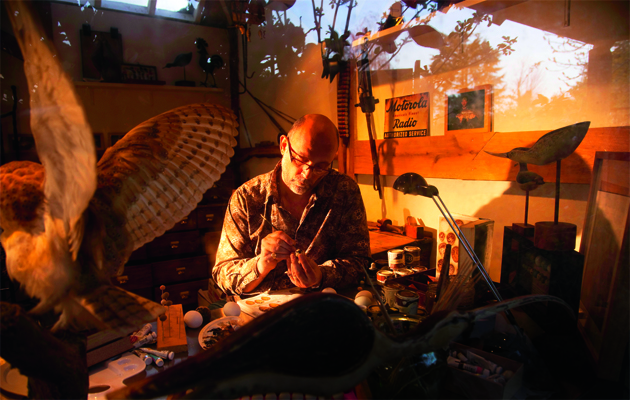Today, the eggs delivered come Easter tend to be of the chocolate variety and collecting wild bird eggshells is a hobby of the past. This was not so for Tony Ladd, who has made a career producing stunning replicas
Today, children tend to experience nature via museums and television programmes. But Tony Ladd’s childhood hobby was collecting wild bird eggshells and now his stunning replicas make extraordinary art. As the long Easter weekend approaches, it is timely reminder that these are the eggs worth celebrating, rather than the gaudily wrapped chocolate variety, delivered by a bunny.
But indeed some kind of egg should be consumed at Easter. Read best luxury eggs for those that would make a more unique eggs and soldiers breakfast – from ostrich eggs to penguins’. And for the essential chocolate fix, try our chocolate, ginger and orange cake. It will make an impressive Easter table centrepiece.
COLLECTING WILD BIRD EGGSHELLS
A few years ago, naturalist and TV presenter Chris Packham said that, “Children need to feel a tadpole tickling the palm of their hand or pull back a bramble to see a nest. I can still remember seeing my first hedge-sparrow nest. It was almost a life-changing moment. I stood there in awe at these amazing little blue eggs, barely able to believe a bird was able to make them.”
These “life-changing” moments are all but lost to the majority of today’s children, who experience nature from the comfort of their living-rooms. The best way to see birds’ eggs now is by visiting natural history museums by appointment, where one can gaze in wonder at a form of reproduction that was a revered symbol of life’s renewal pre-Christianity. Sing that to the magpies who raid the nests of songbirds across the land. Be sad at the freefall in numbers of skylarks, nightingales and cuckoos and shocked that starlings and song thrushes are on the RSPB’s “red alert” list.
Tony Ladd, ornithologist, wildlife artist and creator of beautiful replica birds’ eggs. He is the person to call upon if you are going to begin a hobby collecting wild bird eggshells. “Even in my lifetime I have noticed that children are often not aware of garden bird names and animals outside the norm. My work will, I hope, reawaken the beauty of natural history, the eggs, insects, bones and shells, which I create in a Victorian style using modern print and production techniques.’’
COLLECTING WILD BIRD EGGSHELLS

Tony Ladd’s British Wading Birds collection
It is no coincidence that most of the customers for Ladd’s egg collections are men aged 60-plus who, during a carefree youth (and pre-1954, when the law forbade it) collected birds’ eggs with the zeal with which they swapped conkers. Collecting wild bird eggshells should be completed in this tradition, following their fathers and grandfathers in what was a natural hobby, building up collections and swapping eggs, emulating the competitive Victorian ornithologist-collector. In later years, this competitiveness turned to obsession with a few sociopaths risking their lives to steal rare eggs.
For Ladd, the beauty of birds’ eggs is in their mimicry of nature. “Each one is a fingerprint series of markings with a dazzling array of colours, from blotches to streaks; the egg of the yellowhammer looks like a scrawl. Each is an original piece of artwork with no two alike, which is utterly fascinating. The patterns vary from species and within species and act as camouflage in the natural world. Except for the woodpigeon, which lays its pure-white eggs right out in the open. And then there are all the different shapes and sizes; from the large egg of the great black-backed gull to the minuscule one of the goldcrest.”
ORNITHOLOGICAL BACKGROUND
Ladd’s background undoubtedly inspired his journey of ornithological and creative discovery. “Growing up on my grandfather’s farm in West Sussex I learned how to identify birds and mammals and I have never forgotten the sawdust-filled drawers that Grandad Bert kept full of birds’ eggs. He would allow me to see them under strict supervision. It was a magical experience. They looked like gemstones, each one a different size and colour; they were his most treasured possessions.’’ The level of accuracy and precision required to create the patterns and scribblings of an eggshell has taken Ladd, a graphic designer by trade, years of painstaking work with much experimentation and many breakages as he learnt mould-making and casting techniques. His research took him to the Oxford Natural History Museum’s private collection of 50,000 eggs. Here, he photographed the Victorian collections. “Armed with this reference data I was able to see the detail required for the perfect result,” he says. His eggs impressed Malgosia Nowak-Kemp, vertebrate collections manager at the museum, when he donated a set of his replica eggs as a gift for giving him access to the collections. “The replicas are very fine indeed,” she says. “The shape and markings are very detailed and naturalistic. They would certainly be suitable for any display in a museum or could be used in general teaching on the diversity of shapes and sizes of bird eggs.”

British Birds of Prey, including the golden eagle, osprey, gulls and the guillemot
Seven years ago, Ladd put his skills and research to the test. His father was the chief stonemason at Chichester Cathedral, where a pair of peregrine falcons had been nesting in the buttresses for many years. “Dad was retiring and as the birds were special to him I decided to paint him a clutch of peregrine eggs as a gift. He absolutely loved them and before long his friends wanted replica sets.”
Ladd’s business collecting wild bird eggshells really took off in 2008, when he launched his website. Such was the demand that he had to suspend the site temporarily and catch up. In 2012, he gave up his day job to produce the eggs full time.
“The eggs start life as wooden masters turned expertly on a lathe by a traditional woodcrafter, Peter West, in Sussex,” he explains. “These are then prepared and sealed and made into silicone moulds from which I cast plaster blanks. I then base-coat them using Farrow & Ball paints and build up the layers with all the detailed scribbles, blotches and spots. A vast range of tools and techniques is required to produce and mimic the true markings of nature.” For the delicate markings on the tiniest of eggs, such as a finch egg, Ladd uses whiskers from his Bengal cat, Tikka Masala. “The final stage is finishing the eggs with a believable surface finish, not gloss or matt but ‘eggshell’. Some eggs are more shiny and some more matt, depending on the species, with woodpeckers, owls and pigeons tending to have the shiniest eggs.’’

Limited-edition egg prints, clockwise from above: guillemot falcon and osprey
Ladd has a wide base of wealthy patrons who are keen on collecting wild bird eggshells and buy everything he produces, including entrepreneur Jack Gratton, who shares his West Sussex home with his collections of Ducati motorbikes and modern art – and Ladd’s egg sets, which he admires so much that he wants the artist to make a replica of every British bird’s egg. “I think Tony is one of the most interesting artists working today,” says Gratton. “He has no idea how valuable he is. He will be discovered. When I first came across his work I could not believe the quality.’’
Ladd’s workload is exacting and diverse. He has created three great auk eggs for the National Museum of Iceland in Reykjavik to exacting measurements (177.7mm high by 86mm wide) and with identical markings. For Sotheby’s Evolution Auction at Summers Place, West Sussex, in November, he created a replica great auk egg. For Liberty of London he recently produced a sellout, bespoke collection of garden birds’ eggs.
Perhaps Ladd’s most ambitious project yet is a self-published, nine-volume set of books, An Oological Record of British Birds. The first volume, the 175-page An Oological Record of British Raptors and their Eggs, showing all the eggs lifesize, will be launched this spring at Marco Pierre White’s Rudloe Hall Hotel near Bath (there’ll be a hundred collectors’ copies, signed on the night and accompanied by a gold pin badge, plus a further 400 books for sale from April). The countryman and restaurateur, who buys Ladd’s prints of birds’ eggs for his restaurants, says. “It’s very simple. Tony Ladd is the best there is at what he does.”





